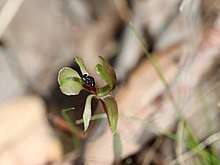Chiloglottis trapeziformis
Chiloglottis trapeziformis, commonly known as the broad-lip bird orchid[2], diamond ant orchid[3] or dainty bird-orchid[4], is a species of orchid endemic to south-eastern Australia. It has two narrow leaves and a narrow, greenish to purplish or brownish flower with a short, shiny black, ant-like callus covering the lower quarter of the diamond-shaped labellum. It has been recorded as a vagrant in New Zealand.
| Broad-lip bird orchid | |
|---|---|
 | |
| Chiloglottis trapeziformis near Acton in the A.C.T. | |
| Scientific classification | |
| Kingdom: | Plantae |
| Clade: | Tracheophytes |
| Clade: | Angiosperms |
| Clade: | Monocots |
| Order: | Asparagales |
| Family: | Orchidaceae |
| Subfamily: | Orchidoideae |
| Tribe: | Diurideae |
| Genus: | Chiloglottis |
| Species: | C. trapeziformis |
| Binomial name | |
| Chiloglottis trapeziformis | |
| Synonyms[1] | |
Description
Chiloglottis trapeziformis is a terrestrial, perennial, deciduous, herb with two leaves 30–80 mm (1–3 in) long and 10–25 mm (0.4–1 in) wide. A single greenish to purplish or brownish flower 12–16 mm (0.5–0.6 in) long and 6–8 mm (0.2–0.3 in) wide is borne on a flowering stem 80–140 mm (3–6 in) high. The dorsal sepal is spatula-shaped, 11–13 mm (0.4–0.5 in) long and about 3 mm (0.1 in) wide. The lateral sepals are linear, 9–12 mm (0.35–0.47 in) long, 1–2.5 mm (0.04–0.1 in) wide and curve downwards and away from each other. There is a glandular tip about 0.5 mm (0.02 in) long on the end of all three sepals. The petals are oblong or broadly linear in shape, 8–15 mm (0.3–0.6 in) long, 3–4 mm (0.1–0.2 in) wide and turned downwards near the ovary. The labellum is erect, diamond-shaped, 7–12 mm (0.3–0.5 in) long and 6–8 mm (0.2–0.3 in) wide with a narrow, shiny black, ant-like callus covering one quarter of its upper surface. Flowering occurs from August to November.[2][3][4][5]
Taxonomy and naming
Chiloglottis trapeziformis was first formally described in 1877 by Robert D. FitzGerald and the description was published in his book Australian Orchids from a specimen collected "at Liverpool".[6]
Distribution and habitat
The broad-lip bird orchid is widespread and common in sheltered sites in a wide range of habitats. It occurs in south-eastern Queensland, eastern New South Wales and eastern Victoria. There is a single small population in south-eastern South Australia and scattered populations at Wynyard, Launceston, Flinders Island and Great Dog Island in Tasmania.[3][5][4][7][8] A single vagrant population, now extinct, was known from a pine plantation near Levin in New Zealand.[9]
Conservation
Chiloglottis trapeziformis is listed as "endangered" in Tasmania under the Threatened Species Protection Act 1995.[8]
References
- "Chiloglottis trapeziformis". World Checklist of Selected Plant Families (WCSP). Royal Botanic Gardens, Kew.
- Bishop, Tony (2000). Field guide to the orchids of New South Wales and Victoria (2nd ed.). Sydney: UNSW Press. p. 117. ISBN 0868407062.
- Jones, David L. (2006). A complete guide to native orchids of Australia including the island territories. Frenchs Forest, N.S.W.: New Holland. p. 142. ISBN 1877069124.
- Stajsic, Val. "Chiloglottis trapeziformis". Royal Botanic Gardens Victoria. Retrieved 23 April 2018.
- Jones, David L. "Chiloglottis trapeziformis". Royal Botanic Garden Sydney. Retrieved 20 April 2018.
- "Chiloglottis trapeziformis". APNI. Retrieved 23 April 2018.
- "Chiloglottis trapeziformis". State Herbarium of South Australia. Retrieved 23 April 2018.
- "Chiloglottis trapeziformis". Government of Tasmania Department of Primary Industries, Parks, Water and Environment. Retrieved 23 April 2018.
- de Lange, Peter J. "Chiloglottis trapeziformis". New Zealand Plant Conservation Network. Retrieved 23 April 2018.
External links

